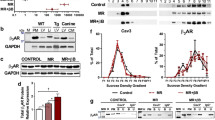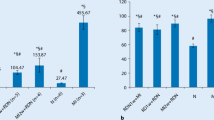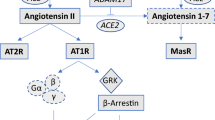Abstract
This study aims to determine whether a relation exists between ischemia/reperfusion and myocardial B-type natriuretic peptide (BNP) mRNA expression independent of variations in intracavitary diastolic volume and consequently, of cardiomyocyte stretching. Twenty-three rats were subjected to the following conditions: control (C), 15 min of ischemia (I15), or ischemia plus 15 (R15), 30 (R30), or 45 (R45) min of reperfusion in the in situ hearts. Isolated hearts of sixteen additional rats (sham, n = 8; occlusion, n = 8) were perfused for studies in the absence of ventricular distension. All hearts were divided in two segments (ischemic and nonischemic). Ventricular distension was avoided by excluding the atria and mitral valves. In both experiments, BNP mRNA was quantified by real-time polymerase chain reaction in both nonischemic and ischemic regions. In the in situ hearts, myocardial BNP mRNA values at R15 (4.24 ± 0.75) in the ischemic region were higher than in other groups (C: 1.43 ± 0.81, P = 0.044; I15: 3.05 ± 0.62, P = 0.048; R30: 0.76 ± 0.84, P = 0.001; R45: 1.47 ± 0.60, P = 0.046, [analysis of variance]). In isolated hearts without ventricular distension, myocardial BNP mRNA (arbitrary units) content at R15 in ischemic regions (4.54 ± 0.26) was greater than in nonischemic regions in both occlusion (3.51 ± 0.20, P < 0.001) and sham (3.38 ± 0.25, P = 0.0001 and 3.47 ± 0.19, P = 0.0001) groups. The present data show that ischemia/reperfusion is responsible for increased BNP mRNA myocardial content independent of changes of ventricular cavity diastolic volume.
Similar content being viewed by others
References
Sudoh, T, Kangawa K, Minamino N, Matsuo H (1988) A new natriuretic peptide in porcine brain. Nature 332:78–81
de Bold AJ, Bruneau BG, de Bold ML (1996) Mechanical and neuroendocrine regulation of the endocrine heart. Cardiovasc Res 31:7–18
Watanabe S, Shite J, Takaoka H, Shinke T, Imuro T, Ozawa T, Otake H, Matsumoto D, Ogasawara D, Paredes OL, Yokoyama M (2006) Myocardial stiffness is a important determinant of the plasma brain natriuretic peptide concentration in patients with both diastolic and systolic heart failure. Eur Heart J 27(7):832–838
Doust JA, Glasziou PP, Pietrzak E, Dobson AJ (2004) A systematic review of the diagnostic accuracy of natriuretic peptides for heart failure. Arch Intern Med 164:1978–1984
Cabanes L, Richaud-Thiriez B, Fulla Y, Heloire F, Weber S, Dusser D (2001) Brain natriuretic peptide blood levels in the differential diagnosis of dyspnea. Chest 120(6):2047–2050
Omland T, Persson A, O’Brien R, Kalrsson T, Herlitz J, Hartford M, Caidahl K (2002) N-terminal pro-B-type natriuretic peptide and long-term mortality in acute coronary syndromes. Circulation 106:2913–2918
Lemos JA, Morrow DA, Bentley JH, Omland T, Sabatine MS, McCabe CH, Hall C, Cannon CP, Braunwald E (2001). The prognostic value of B-type natriuretic peptide in patients with acute coronary syndromes. N Engl J Med 345:1014–1021
Arakawa N, Nakamura M, Aoki H (1996). Plasma brain natriuretic peptide concentrations predict survival after myocardial infarction. J Am Coll Cardiol 27:1656–1661
Omland T, Lemos JA, Morrow DA, Antman EM, Cannon CP, Hall C, Braunwald E (2002) Prognostic value of N-terminal proatrial and pro-brain natriuretic peptide in patients with acute coronary syndromes. J Am Coll Cardiol 89:463–465
Goetze JP, Christoffersen C, Perko M, Arendrup H, Rehfeld JF, Kastrup J, Nielsen LB (2003) Increased cardiac BNP expression associated with myocardial ischemia. FASEB J 17:1105–1107
Goetze JP, Gore A, Moller CH, Steinbruchel DA, Rehfeld JF, Nielsen LB (2004) Acute myocardial hypoxia increases BNP gene expression. FASEB J 18:1928–1930
Tóth M, Vuorinen KH, Vuolteenaho O, Hassinen IE, Uusimaa PA, Leppäluoto J, Ruskoaho H (1994) Hypoxia stimulates release of ANP and BNP from perfused rat ventricular myocardiaum. Am J Physiol Heart Circ Physiol 266:H1572–H1580
D’souza SP, Yellon DM, Martin C, Schulz R, Heusch G, Onody A, Ferdinandy P, Baxter GF (2003) B-type natriuretic peptide (BNP) limits infarct size in rat isolated heart via K ATP channel opening. Am J Physiol Heart Circ Physiol 284:H1592–H1600
Himori N, Matsuura A (1989) A simple technique for occlusion and reperfusion of coronary artery in conscious rats. Am J Physiol Heart Circ Physiol 256:H1719–H1725
Spadaro J, Fishbein MC, Hare C, Pfeffer MA, Maroko PR (1980) Characterization of myocardial infarcts in the rat. Arch Pathol Lab Med 104:179–183
Kyriakides ZS, Markianos M, Michalis L, Antoniadis A, Nikolaou NI, Kremastinos DT (2000) Brain natriuretic peptide increase much more proeminently than atrial natriuretic peptide during coronary angioplasty. Clin Cardiol 23:285–288
Tateishi J, Masutani M, Ohyanagi M, Iwasaki T (2000) Transient increase in plasma brain (B-type) natriuretic peptide after percutaneous transluminal coronary angioplasty. Clin Cardiol 23: 776–780
Lemos JA, Morrow DA, Bentley JH, Omland T, Sebatine MS, McCabe CH, Hall C, Cannon CP, Braunwald E (2001) The prognostic value of B-type natriuretic peptide in patients with acute coronary syndromes. N Engl J Med 345:1014–1021
Nishikimi T, Mori H, Ishimura K, Tadakoro K, Yagi H, Yabe A, Horinaka S, Matsuoka H (2004) Association of plasma atrial natriuretic peptide, N-terminal proatrial natriuretic peptide and brain natriuretic peptide levels with coronary artery stenosis in patients with normal left ventricular systolic function. Am J Med 116: 517–523
Inoue T, Sakuma M, Yaguchi I, Mizoguchi K, Uchida T, Takayanaqi K, Hayashi T, Morooka S (2002) Early recanalization and plasma brain natriuretic peptide as an indicator of left ventricular function after myocardial infarction. Am Heart J 143: 790–796
Bassan R, Potsch A, Maisel A, Tura B, Villacorta H, Nogueira MV, Campos A, Gamarski R, Massetto AC, Moutinho MA (2005) B-type natriuretic peptide: a novel early blood marker of acute myocardial infarction in patients with chest pain and no ST-segment elevation. Eur Heart J 26:234–240
Sajadieh A, Nielsen OW, Rasmussen V, Hansen JF (2007) NT-pro-brain natriuretic peptide is significantly elevated in subjects with daily-life silent myocardial ischemia and no other evidence of heart disease. Eur Heart J 28(abstract suppl):771
Stauber D, Nusbaumer C, Zellweger MJ, Jonas N, Wild D, Pfisterer ME, Mueller-Brand J, Perruchoud AP, Mueller C (2006) Use of B-type natriuretic peptide in detection of myocardial ischemia. Am Heart J 151:1223–1230
Zaid Gh, Tanchilevitch E, Rivlin E, Gropper R, Rosenschein U, Lanir A, Goldhammer E (2007) Diagnostic accuracy of serum B-type natriuretic peptide for myocardial ischemia detection during exercise testing with spect perfusion imaging. Int J Cardiol 117:157–164
Win HK, Chang S, Raizner M, Shah G, Al Basky F, Desai U, Plana JC, Mahmarian JJ, Quinones MA, Zoghbi WA (2005) Percent change in B-type natriuretic peptide levels during treadmill exercise as a screening test for exercise-induced myocardial ischemia. Am Heart J 150:695–700
Wolber T, Maeder M, Weilenmann D, Duru F. Bluzaite I, Riesen W, Rickli H, Ammann P (2006) Integration of B-type natriuretic peptide levels with clinical data and exercise testing for predicting coronary artery disease. Am J Cardiol 98:764–767
Weidemann A, Klanke B, Wagner M, Volk T, William C, Wiesener MS, Eckardt KU, Warnecke C (2008) Hypoxia, via stabilization of hypoxia-inducible factor (HIF) alpha is a direct and sufficient stimulus for B-type natriuretic peptide induction. Biochem J 409:233–242
Goswani SK, Maulik N, Das DK (2007) Ischemia/reperfusion and cardioprotection: a delicate balance between reactive ixigem species generation and redox homeostasis. Ann Med 39:275–289
Cheng L, Ma S, Wei LX, Guo HT, Huang LY, Bi H, Fan R, Li J, Liu YL, Wang YM, Sun X, Zhang QY, Yu SQ, Yi DH, Ma XL, Pei JM (2007) Cardioprotective and antiarrhythmic effect of U50, 488H in ischemia/reperfusion rat heart. Heart Vessels 22:335–344
Nikbakht-Sangari M, Qayumi AK, Keown PA (2000). The role of inflammatory mediators in the mechanism of the host immune response induced by ischemia/reperfusion injury. Immunol Invest 29:13–16
Bai CG, Liu XH, Liu WQ, Ma DL (2008) Regional expression of the hypoxia-inducible factor (HIF) system and association with cardiomyocyte cell cycle re-entry after myocardial infarction in rats. Heart Vessels 23:193–200
De Sutter J, De Bacquer D, Cuypers S, Delanghe J, Buyzere M, Kornitzer M, Backer G (2005) Plasma N-terminal pro-BNP concentration predicts coronary events in men at work: a report from the BELSTRESS study. Eur Heart J 26:2644–2649
Jarai R, Iordanova N, Jarai R, Raffetseder A, Woloszczuk W, Gyongyosi M, Geyer G, Wojta J, Huber K (2005) Risk assessment in patient with unstable angina/non-ST-elevation myocardial infarction and normal N-terminal pro-BNP levels by N-terminal pro-ANP. Eur Heart J 26:250–256
Vergès B, Zeller M, Desgrès J, Dentan G, Laurent Y, Janin-Manificat L, L’Huillier I, Rioufol G, Beer JC, Makki H, Rochette L, Gambert P, Cottin Y on behalf of RICO survey working group (2005) High plasma NT-pro-BNP level found in diabetic patients after myocardial infarction is associated with an increased risk of in-hospital mortality and cardiogenic shock. Eur Heart J 26: 1734–1741
Schnabel R, Rupprecht HJ, Lackner KJ, Lubos E, Bickel C, Meyer J, Munzel T, Cambien F, Tiret L, Blankenberg S for the Athero-Gene Investigators (2005) Analysis of NT-pro-BNP and C-reactive protein for risk stratification in stable and unstable coronary artery disease: results from the AtheroGene study. Eur Heart J 26: 241–249
Kragelund C, Gronning B, Kober L, Hildebrandt P, Steffensen R (2005) NT-pro-BNP and long-term mortality in stable coronary artery disease. N Engl J Med 352:666–675
Author information
Authors and Affiliations
Corresponding author
Rights and permissions
About this article
Cite this article
Ramos, L.W.F., Murad, N., Goto, E. et al. Ischemia/reperfusion is an independent trigger for increasing myocardial content of mRNA B-type natriuretic peptide. Heart Vessels 24, 454–459 (2009). https://doi.org/10.1007/s00380-009-1148-z
Received:
Accepted:
Published:
Issue Date:
DOI: https://doi.org/10.1007/s00380-009-1148-z




